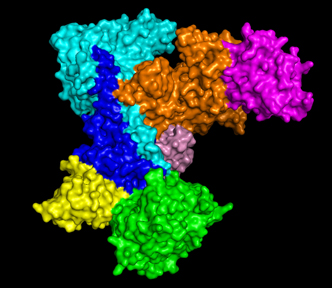Home | About | Faculty | Calendar | Facilities | Graduate program | Contact | Apply
This page is optimized for viewing with javascript.
Brad Nolen

Associate professor, Chemistry and Biochemistry
Member, IMB
Ph.D., U.C. San Diego
B.S., Missouri State University
Email
Lab website
Office: Klamath Hall Room 293
Office Phone: 541-346-7412
Loading profile for Brad Nolen
Research Interests
The Nolen lab is investigating the molecular basis for regulation of the cytoskeleton, the molecular framework that provides physical support for cells. One of our primary interests is actin, a highly conserved eukaryotic protein which polymerizes into two-stranded helical filaments. Rearrangements of the actin filament network are critical for cellular processes that require a change in cell shape, such as motility, uptake and release of materials and cell division. To regulate these processes, cells utilize a myriad of proteins to control polymerization, depolymerization, severing, capping and crosslinking of actin filaments.
Actin filaments are generated de novo by actin nucleator proteins, which bring the first few actin monomers together to form a template for filament elongation. Arp2/3 complex, a 225kD assembly of seven subunits (Arp3, Arp2, ARPC1-5) is one such nucleator. Arp2/3 complex is intrinsically inactive, and activation requires binding to an activator, such as a WASp/Scar family protein, and recruitment of the complex to the side of a pre-existing actin filament. Once activated, the complex nucleates the growth of a new filament which is anchored to the pre-existing filament at a 78˚ angle. This process results in the formation of tightly crosslinked, highly branched filament networks.
 Surface representation of the x-ray crystal structure of inactive Arp2/3 complex from Bos taurus.
Surface representation of the x-ray crystal structure of inactive Arp2/3 complex from Bos taurus.
Arp2/3 complex is essential in the formation of invadopdia, cellular structures essential for the migration of tumor cells through the basal lamina into the blood stream. Invading bacterial and viral pathogens usurp Arp2/3 complex in host cells to escape detection by the immune system. Despite the biomedical importance of the complex, many fundamental questions about how it functions remain unanswered. For instance, how do activator proteins like WASp/Scar activate Arp2/3 complex? How is the proposed activating conformational change accomplished and how does this change promote formation of the filament nucleus?
We use a combination of biochemistry, biophysics, x-ray crystallography and molecular dynamics simulations to investigate these questions, and our ultimate goal is to understand how phenomena observed at the cellular level are controlled at the molecular level. Therefore, we are especially interested in experimental systems in which we can test our findings in vivo. Schizosaccharomyces pombe provides one such system, since it is genetically tractable, can be used for production of the large quantities of protein required for x-ray crystallography and is suitable for microscopy.
Recent publications
(pulled from pubmed)
Recent publications
(pulled from pubmed)
Helgeson LA, Prendergast JG, Wagner AR, Rodnick-Smith M, Nolen BJ
J Biol Chem 2014 Oct 17;289(42):28856-69
Liu SL, May JR, Helgeson LA, Nolen BJ
J Biol Chem 2013 Jan 4;288(1):487-97
Hetrick B, Han MS, Helgeson LA, Nolen BJ
Chem Biol 2013 May 23;20(5):701-12
Luan Q, Nolen BJ
Nat Struct Mol Biol 2013 Sep;20(9):1062-8
Helgeson LA, Nolen BJ
Elife 2013 Sep 3;2:e00884
Wagner AR, Luan Q, Liu SL, Nolen BJ
Curr Biol 2013 Oct 21;23(20):1990-8
Baggett AW, Cournia Z, Han MS, Patargias G, Glass AC, Liu SY, Nolen BJ
ChemMedChem 2012 Jul;7(7):1286-94
Liu SL, Needham KM, May JR, Nolen BJ
J Biol Chem 2011 May 13;286(19):17039-46
Ti SC, Jurgenson CT, Nolen BJ, Pollard TD
Proc Natl Acad Sci U S A 2011 Aug 16;108(33):E463-71
Ezezika OC, Younger NS, Lu J, Kaiser DA, Corbin ZA, Nolen BJ, Kovar DR, Pollard TD
J Biol Chem 2009 Jan 23;284(4):2088-97
Nolen BJ, Tomasevic N, Russell A, Pierce DW, Jia Z, McCormick CD, Hartman J, Sakowicz R, Pollard TD
Nature 2009 Aug 20;460(7258):1031-4
Dalhaimer P, Pollard TD, Nolen BJ
J Mol Biol 2008 Feb 8;376(1):166-83
Nolen BJ, Pollard TD
J Biol Chem 2008 Sep 26;283(39):26490-8
Nolen BJ, Pollard TD
Mol Cell 2007 May 11;26(3):449-57
Nolen BJ, Littlefield RS, Pollard TD
Proc Natl Acad Sci U S A 2004 Nov 2;101(44):15627-32